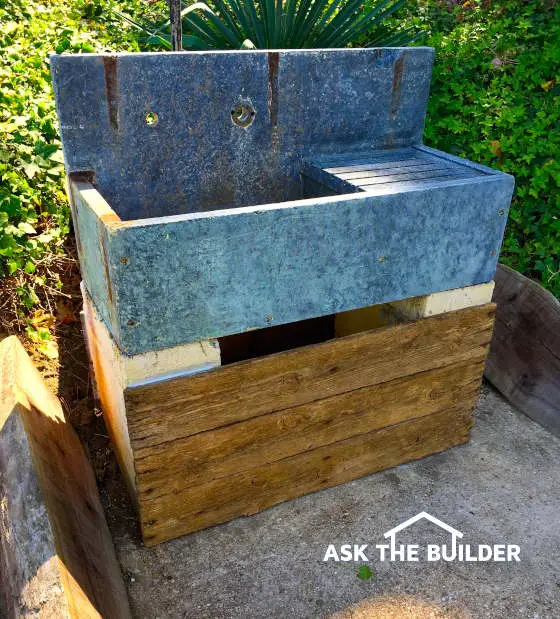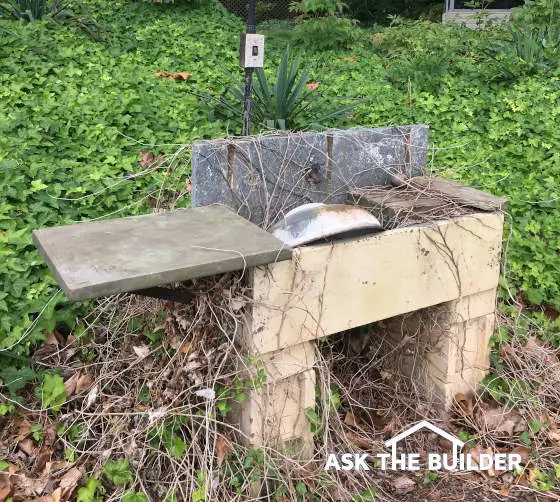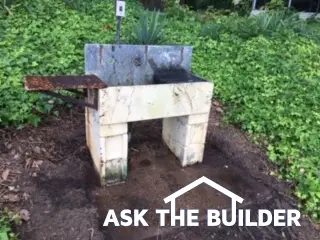Outdoor Sink Restoration & Handrail on Brick Wall

Outdoor Sink Restoration | This is a stunning outdoor sink (featured in the September 22, 2019 AsktheBuilder Newsletter) made from natural stone. It was originally installed to clean fish. Special sealers should be used to preserve it. (C) Copyright 2019 Tim Carter
Outdoor Sink Restoration
QUESTION #1: I’m in the process of restoring a grand natural stone outdoor sink. It’s made from some type of natural stone. Locals tell me it’s soapstone. Once restored, it’s going to be used as a beverage serving station for outdoor parties. Someone painted it years ago and after stripping the paint, the stone is a matte finish and rather dull. I’d like to enhance the color and protect it from the elements. What would you recommend? JoAnne G., Earleville, MD
My college degree is in geology and I can tell you that just about every natural stone has a natural resistance to weathering. This is but one reason why mountains exist. That said, it can be a good idea to seal certain polished stones to minimize deterioration from freezing weather and oils that might stain the stone.
JoAnne sent me several photos of this grand sink and they’re all visible on my AsktheBuilder.com website. The stone does resemble soapstone in appearance. There’s an easy way to determine it as soapstone. True soapstone is a metamorphic rock that’s got a high content of talc. Talc is extremely soft and soapstone can be scratched with relative ease.

Soapstone also feels smooth and slick when dry just like wet soap. Stone fabricators often tell homeowners who use soapstone for countertops to coat the stone with linseed oil. My experience has been dreadful doing this as everything you set on it picks up the oil. Do this outdoors and your soapstone will be black in weeks as mold and mildew will feast on the natural oil.
My suggestion is to purchase a cordless electric orbital buffing tool that car body shop techs use. I’d invest in some marble polishing compounds to bring back the luster of the natural stone. Start on the rear of the tall panel until you determine the correct method to get a fine polish.
There are quite a few great videos online showing how to polish marble. Watch those as soapstone reacts to polishing just as marble does.
Once you get the stone looking as good as possible, I’d then test out on the sink back the clear penetrating sealers recommended for use on granite countertops. These sealers can penetrate into the microscopic cracks in granite and will do the same in the soapstone. The sealers work well on just about every natural stone. Simply read the label to see if there are restrictions.
Don’t expect a sealer alone to product magical results if the stone is dull and scratched. The stone needs to be polished before sealing. Beware of sealers that are like urethane or varnish. These form a film on top of the stone and will eventually peel leaving a huge mess.

Handrail on Brick Wall
QUESTION #2: Help Tim! I need to install a wrought iron handrail down an exterior stairwell. One of the mounting brackets will be on the poured concrete foundation wall but the other one must be on the exterior brick. I don’t want to ruin the brick and realize I must get this right the first time. What would you do to prevent the handrail from pulling away from the wall? Ken B., Homewood, IL
Ken’s facing an interesting conundrum. You do usually only get one chance to get this installation right. Ideally, it would have been best to put in through bolts in the masonry walls, but this is also extremely problematic.
I’ve tested all sorts of masonry anchors over the years and some are far better than others. Lately, I’ve had the best success coupling wedge anchors with high-strength epoxy.
A wedge anchor looks just like a normal threaded bolt at one end. However, the business end of the anchor is cone-shaped end and a secondary steel sleeve fits over the cone. As you tighten a nut at the end of the anchor it pulls the cone-shaped end into the sleeve causing the sleeve to grow in diameter and wedge itself into the masonry.
This friction helps offset the pulling force exerted by the weight of the handrail and anyone pulling on it. However, I’ve had failures with just using the anchors alone even though I made sure the drilled hole was not oversized and the hole was free of grit and dust.
I decided to start testing a new method where I angle the hole as I drill into the masonry. I move the drill left and right about 15 degrees off-center to create a hole that is much wider deep in the masonry than the small-diameter hole that you can see on the face of the brick or concrete.
I blow out all the grit and use a bottle brush to make sure every bit of dust is removed from the cavity. I then squirt in a special concrete epoxy so the hole is just about filled. I coat the wedge anchor and then push it into the hole so that some of the epoxy squirts out. I clean off the epoxy and allow it to cure for 48 hours before applying tension.
IMPORTANT NOTE:
I created a special column about Ken's project with photos and a list of all products I suggested he use. CLICK HERE to read the column on how to install handrail into brick.
Column 1322
2 Responses to Outdoor Sink Restoration & Handrail on Brick Wall